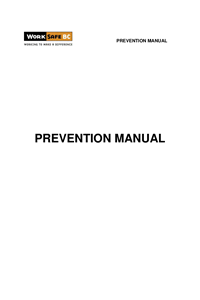Archived Prevention Manual - January 1, 2016 - January 31, 2016
This edition of the Prevention Manual reflects the following updates.
The Prevention Manual contains WorkSafeBC policy with respect to matters under Part 3 (Occupational Health and Safety) of the Workers Compensation Act (Act) and the Occupational Health and Safety Regulation. The Act requires WorkSafeBC and the Workers’ Compensation Appeal Tribunal to apply these policies when making decisions.
The Prevention Manual is provided here in Adobe Acrobat portable document format (PDF). The PDF files reflect the current manual, and include the most recent update issued January 1, 2016. See Prevention Manual updates below.
The Workers Compensation Act, Occupational Health and Safety Regulation and associated Guidelines are also available online.
This edition of the Prevention Manual reflects the following updates.
Procedures and Resolving Disagreements (D4-132/133-1)
Housekeeping changes were made to the background section of this policy to reflect the Bill 35 Act changes. If WorkSafeBC considers that a joint committee is unable to reach agreement on a matter relating to the health or safety of workers at the workplace, the Board, on its own initiative, may investigate the matter and attempt to resolve the matter.
Major Release of Hazardous Substance (D10-172-1)
A housekeeping change was made to reflect the addition of a section in the Act imposing a duty on the employer to notify WorkSafeBC of an accident involving a fire or explosion that had a potential for causing serious injury to a worker.
Full Incident Investigation, Report and Follow-Up Action (D10-176-1)
The final versions of policies related to employer incident investigations, reflecting stakeholder feedback on the interim incident investigation policies and Bill 35 came into effect January 1, 2016. Bill 35 revised the incident investigation sections of the Act to require employers to provide copies of their incident investigation reports to the joint committee or worker health and safety representative, as applicable, or if neither exist, to post the reports at the workplace. Employers must provide their preliminary investigation reports as soon as practicable, and their full investigation reports within 30 days of the occurrence of the incident (subject to extensions).
OHS Compliance Agreements (D12-186.1-1)
Bill 9 introduced the Compliance Agreements tool. Instead of issuing an order, WorkSafeBC may, in certain circumstances, enter into a Compliance Agreement in which an employer voluntarily agrees to correct OHS violations and report back to WorkSafeBC by a certain date. Compliance Agreements are offered at WorkSafeBC's discretion, within the limits of the Act and policy. WorkSafeBC will only enter into a Compliance Agreement if WorkSafeBC believes that the employer will likely fulfill its obligations under the agreement. An interim OHS Compliance Agreements policy providing additional guidance regarding the compliance agreement provisions was effective September 15, 2015. The finalized policy became effective January 1, 2016.
Stop Work Orders (D12-191-1)
Bill 9 expanded the criteria and lowered the threshold for issuing stop work orders. The changes also allow WorkSafeBC to stop work or prevent work from starting at multiple locations for an employer (called "stop operations") if similar unsafe conditions are likely to exist at the other locations. An interim Stop Work Orders policy providing additional guidance regarding the changed stop work order provisions was effective May 27, 2015. The finalized policy became effective January 1, 2016.
Various Policies: Consumer Price Index adjustments
Section 25.2 of the Act is adjusted by WorkSafeBC according to changes in the Consumer Price Index. Policies affected include: Policy D12-196-4 — Penalties — Authority to Impose, Policy D12-196-6 — Penalties — Amount of Penalty, D24-73-1 — Imposition of Levies — Charging of Claim Costs.

